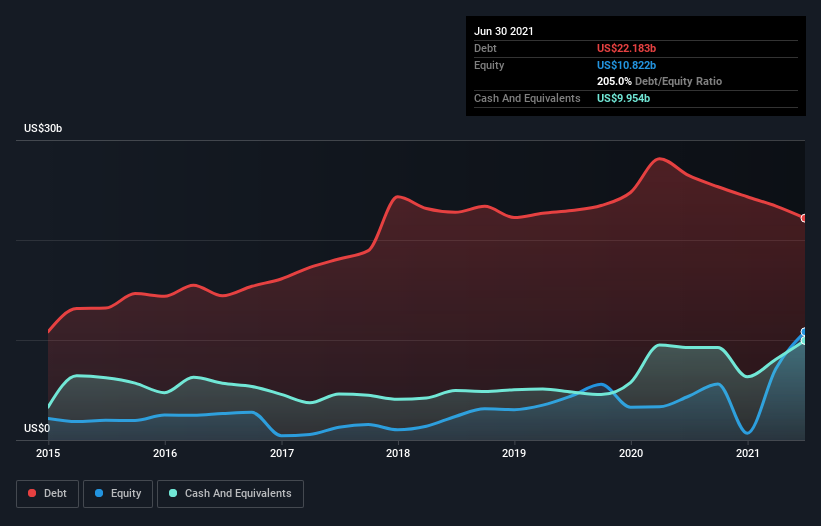
United Parcel Service, Inc. (NYSE:UPS) released third quarter results yesterday. The stock price gained nearly 7% after the company beat consensus estimates on the top and bottom line and raised full year guidance.
Highlights from the quarterly results:
- Consolidated revenues were up 9.2% year-on-year, to $23.2b. This increase was off a high base set a year ago, and 27% higher than the third quarter in 2019.
- Diluted EPS were up 18.3% year-on-year at $2.71.
- US Domestic segment operating profit up 28%.
- Full year guidance for revenue growth raised to 13.8%.
- Full year guidance for operating margin raised to 13%.
The market evidently approved of these results and is anticipating a strong holiday season despite the ongoing supply chain issues.
One aspect of UPS that may concern investors is the high level of debt. The company’s debt to equity ratio is 2.05 which is very high, so we decided to take a closer look at how manageable this debt is.
Why Does Debt Bring Risk?
Debt and other liabilities become risky for a business when it cannot easily fulfill those obligations, either with free cash flow or by raising capital at an attractive price. In the worst case scenario, a company can go bankrupt if it cannot pay its creditors. However, a more usual (but still expensive) situation is where a company must dilute shareholders at a cheap share price simply to get debt under control. By replacing dilution, though, debt can be an extremely good tool for businesses that need capital to invest in growth at high rates of return. When we examine debt levels, we first consider both cash and debt levels, together.
View our latest analysis for United Parcel Service
How Much Debt Does United Parcel Service Carry?
As you can see below, United Parcel Service had US$22.2b of debt at June 2021, down from US$26.5b a year prior. However, it also had US$9.95b in cash, and so its net debt is US$12.2b.
How Strong Is United Parcel Service's Balance Sheet?
Zooming in on the latest balance sheet data, we can see that United Parcel Service had liabilities of US$15.8b due within 12 months and liabilities of US$38.3b due beyond that. Offsetting this, it had US$9.95b in cash and US$10.5b in receivables that were due within 12 months. So its liabilities outweigh the sum of its cash and (near-term) receivables by US$33.6b.
Since publicly traded United Parcel Service shares are worth a very impressive total of US$189.9b, it seems unlikely that this level of liabilities would be a major threat. Having said that, it's clear that we should continue to monitor its balance sheet, lest it change for the worse.
In order to size up a company's debt relative to its earnings, we calculate its net debt divided by its earnings before interest, tax, depreciation, and amortization (EBITDA) and its earnings before interest and tax (EBIT) divided by its interest expense (its interest cover). Thus we consider debt relative to earnings both with and without depreciation and amortization expenses.
United Parcel Service has net debt of just 1.2 times EBITDA, suggesting it could ramp leverage without breaking a sweat. In addition, UPS actually managed to receive more interest than it paid, over the last year. So it's fair to say it can handle debt quite easily with the current level of earnings. In addition to that, we're happy to report that United Parcel Service has boosted its EBIT by 34%, thus reducing the spectre of future debt repayments. The balance sheet is clearly the area to focus on when you are analysing debt. But ultimately the future profitability of the business will decide if United Parcel Service can strengthen its balance sheet over time. So if you're focused on the future you can check out this free report showing analyst profit forecasts.
Finally, a company can only pay off debt with cold hard cash, not accounting profits. So the logical step is to look at the proportion of that EBIT that is matched by actual free cash flow. During the last three years, United Parcel Service generated free cash flow amounting to a very robust 87% of its EBIT, more than we'd expect. That positions it well to pay down debt if desirable to do so.
Our View
Our conclusion is that UPS can manage its debt with the current level of earnings - though it may become a problem if revenue or margins decline. But debt is just one aspect of a company that should be considered when making an investment. In particular, the valuation and outlook for earnings should be considered.
Have a look at our latest analysis for United Parcel Service for a full overview of the company as well as a few warning signs we have identified.
Of course, if you're the type of investor who prefers buying stocks without the burden of debt, then don't hesitate to discover our exclusive list of net cash growth stocks, today.
If you're looking to trade United Parcel Service, open an account with the lowest-cost platform trusted by professionals, Interactive Brokers.
With clients in over 200 countries and territories, and access to 160 markets, IBKR lets you trade stocks, options, futures, forex, bonds and funds from a single integrated account.
Enjoy no hidden fees, no account minimums, and FX conversion rates as low as 0.03%, far better than what most brokers offer.
Sponsored ContentNew: AI Stock Screener & Alerts
Our new AI Stock Screener scans the market every day to uncover opportunities.
• Dividend Powerhouses (3%+ Yield)
• Undervalued Small Caps with Insider Buying
• High growth Tech and AI Companies
Or build your own from over 50 metrics.
Have feedback on this article? Concerned about the content? Get in touch with us directly. Alternatively, email editorial-team@simplywallst.com
Simply Wall St analyst Richard Bowman and Simply Wall St have no position in any of the companies mentioned. This article is general in nature. We provide commentary based on historical data and analyst forecasts only using an unbiased methodology and our articles are not intended to be financial advice. It does not constitute a recommendation to buy or sell any stock and does not take account of your objectives, or your financial situation. We aim to bring you long-term focused analysis driven by fundamental data. Note that our analysis may not factor in the latest price-sensitive company announcements or qualitative material.

Richard Bowman
Richard is an analyst, writer and investor based in Cape Town, South Africa. He has written for several online investment publications and continues to do so. Richard is fascinated by economics, financial markets and behavioral finance. He is also passionate about tools and content that make investing accessible to everyone.
About NYSE:UPS
United Parcel Service
A package delivery and logistics provider, offers transportation and delivery services.
Very undervalued with adequate balance sheet and pays a dividend.
Similar Companies
Market Insights
Community Narratives


